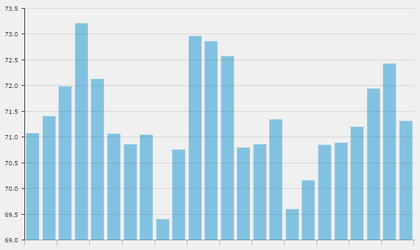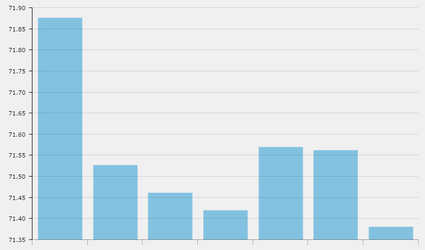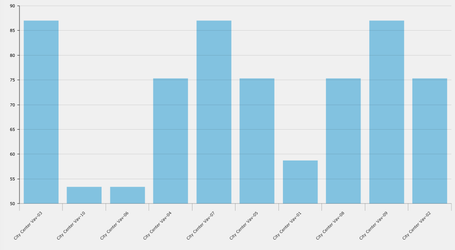/
Am Charts
Am Charts
Code
Date Range am Chart
Below is an example of how a user can create a chart with multiple predefault filters. In this example, we'll create two buttons to switch between. One for today rollup up by 1 hr with avg. The other for this week rollup 1 day with avg. You can choose your own preferred tags, just make sure to replace them in the corresponding areas we are using them in. We'll also explain how the $1, $2 etc work. They aren't required, but it can be useful depending on what you are trying to do.
- Tag the amChart component as "foo"
- Drag out two buttons and on them add the following string tags and one marker tag:
- dateRange - set value as "today" for one button and the other as "thisWeek". This is the filter for the hisRead where is it has $2. Its defined in the program as "this.dateRange".
- math - set value as "avg" on both buttons. This is the filter for the first parameter in hisRollup where it has $3. Its defined in the program as "this.math".
- interval - set value as "1hr" for the today button and "1day" for the other. This is a filter for the second parameter in the hisRollup where it has $4. Its defined in the program as "this.interval".
- chartButton - this is just a marker tag on which the program will run on as well.
- Create a program and make it run on "world or chartButton" with TO BE CONTINUED.
var myChart = query('foo');
var myTarget = query('targetPoint');
var myQuery = sprintf('read(point and temp and sensor and equipRef==$1).hisRead($2).hisRollup($3, $4)',myTarget.pointId,this.dateRange,this.math,this.interval);
var promise = finstack.eval(myQuery);
promise.then(function(event)
{
var jason = event.result.toObj();
var chart = AmCharts.makeChart( myChart.view, {
"type": "serial",
"theme": "light",
"dataProvider": jason,
"gridAboveGraphs": true,
"startDuration": 1,
"graphs": [ {
"balloonText": "[[category]]: <b>[[value]]</b>",
"fillAlphas": 0.8,
"lineAlpha": 0.2,
"type": "column",
"valueField": "v0"
} ],
"chartCursor": {
"categoryBalloonEnabled": false,
"cursorAlpha": 0,
"zoomable": false
},
"categoryField": "ts",
"categoryAxis": {
"gridPosition": "start",
"gridAlpha": 0,
"tickPosition": "start",
"tickLength": 20,
"labelsEnabled": false
},
"export": {
"enabled": true
}
});
});
End result with both today and thisWeek results in that order.
Sample Bar Chart with Columns clicking on columns and getting Magic Bubbles.
var myPoint = query('virtualPoint and query');
var myChart = query('foo');
function magicBubbles(ev){
var myPointId = ev.item.dataContext.id;
top.app.ShowRelatedBubbles(myPointId,myPointId,false,context.event);
// console.log(ev)
}
var chart = AmCharts.makeChart( myChart.view, {
"type": "serial",
"theme": "light",
"dataProvider": myPoint.curVal.toObj(),
"gridAboveGraphs": true,
"startDuration": 1,
"graphs": [ {
"balloonText": "[[dis]]: <b>[[area]]</b>",
"fillAlphas": 0.8,
"lineAlpha": 0.2,
"type": "column",
"valueField": "area"
} ],
"chartCursor": {
"categoryBalloonEnabled": false,
"cursorAlpha": 0,
"zoomable": false
},
"categoryField": "dis",
"categoryAxis": {
"gridPosition": "start",
"gridAlpha": 0,
"tickPosition": "start",
"tickLength": 20
},
"export": {
"enabled": true
},
"listeners": [ {
"event": "clickGraphItem",
"method": magicBubbles
}]
} );
Pie Chart with Slices clickable to Magic Bubbles
var myChart = query('foo');
var myQuery = query('virtualPoint and query');
function handleZoom(ev){
var myPointId = ev.dataItem.dataContext.id;
top.app.ShowRelatedBubbles(myPointId,myPointId,false);
}
var chart = AmCharts.makeChart( myChart.view, {
"type": "pie",
"theme": "light",
"dataProvider": myQuery.curVal.toObj(),
"valueField": "area",
"titleField": "dis",
"balloon":{
"fixedPosition":true
},
"export": {
"enabled": true
},
"listeners": [ {
"event": "clickSlice",
"method": handleZoom
}]
} );
Downloads
Custom Chart w/ Magic Bubbles
Download: customChartA.zip
- Go to folio view in the smart menu and select "restore"
- Download the customChartA.zip and drag it into the restore window
- Now you will have the customChartA saved as a model, which will be accessible in your graphic component library
- All you need to do to make the chart work is create a virtualPoint query and the chart will automatically load up the curVals of each result into a bar.
Related content
Dynamic Chart
Dynamic Chart
More like this
History Comparison Chart
History Comparison Chart
More like this
Simple Column Chart
Simple Column Chart
More like this
3D Bar Chart
3D Bar Chart
More like this
FIN Chart Components (finAmChartsReactExt)
FIN Chart Components (finAmChartsReactExt)
Read with this
AM Chart Show Hide Scroll
AM Chart Show Hide Scroll
More like this


